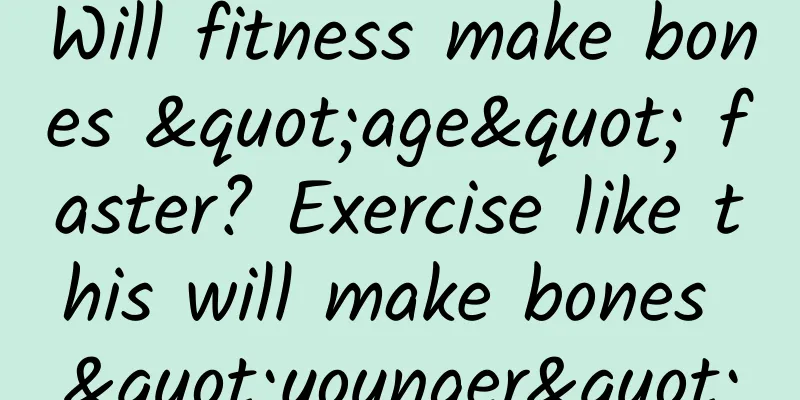Will fitness make bones "age" faster? Exercise like this will make bones "younger"

|
Reviewer: Qian Jinghua, Professor of Beijing Sport University Figure 1 Copyright image, no permission to reprint Whether for health or weight loss, many people regard exercise and fitness as a lifestyle. But there is also a view that the more exercise you do, the faster your bones will age. Does this statement make sense? Will exercise and fitness accelerate the "aging" of our bones? How can we exercise to make our bones more "young"? First, let's understand how the skeletal musculoskeletal system works. The mechanism of action of the musculoskeletal system Our skeletal muscle movement has 4 elements, namely bones, muscles, cartilage and ligaments. Take running as an example. When we run, the spine and pelvis of the upper body tilt slightly forward, so that the upper body remains in a relatively stable state. The thighs, calves, knees and ankles of the lower limbs support us to complete the running action [1]. During this process, the leg muscles will contract and move the thigh and calf forward together, increasing the pace of the step[1]. The cartilage at each joint is responsible for absorbing the impact force generated when running, which not only protects the bones from damage but also makes running smoother[1]. The ligaments in our body ensure that multiple bones can maintain a relatively good movement mode, avoid dislocation, and can stably perform flexion and extension movements, driving the lower limbs to run forward[1]. It can be seen that the above four elements are indispensable to our skeletal musculoskeletal motor system, and only when they work together can we exercise effectively [1]. The reason why there is a saying that "the more you exercise, the faster your bones age" is mainly because people have problems with their skeletal muscle movement system during exercise, such as knee pain, etc. However, this problem has nothing to do with exercise itself, but is caused by incorrect exercise. Many times, we are not clear about which movements cause damage to the skeletal musculoskeletal system, and the result is that the damage continues during continued exercise. Sometimes, the body has actually sent out warning signals, such as soreness, but we don't pay attention to it. If we don't take good measures to save the situation in the early stages of the symptoms, the consequences will become more and more serious. Figure 2 Copyright image, no permission to reprint Choose the sport that suits you So, how should we exercise to make our bones younger? It is important to choose the exercise that suits you. First, we need to know our body mass index and then choose the level of exercise. Body mass index is weight in kilograms divided by the square of height (kg/m²). Different exercise methods are required for adults with different body mass index ranges. If the body mass index is relatively high, above 33 kg/m², it is considered severe obesity. In this case, we should first consider how to control diet and reduce weight appropriately. On the basis of controlling diet, we can do some light-intensity aerobic training, such as aerobics. High-intensity sports, such as playing ball, climbing mountains, rock climbing, etc., should not be tried for the time being. Because when you are overweight, these high-intensity sports will put a great load on the skeletal muscle movement system and cause certain damage to the body. If your body mass index is between 28 and 33 kg/m², it is recommended that you do some aerobic exercise that does not put too much load on your joints, such as cycling and yoga, which can reduce the damage to your joints caused by your body weight. At the same time, you can also combine it with appropriate muscle strength training to achieve the goal of controlling your weight and exercising your muscles. If your body mass index is below 28 kg/m², you can choose your favorite exercise, but be careful to proceed step by step and not to exert too much force at once, so as not to cause muscle soreness and ligament strain. The body also needs to adapt little by little through continuous exercise. After knowing the type of exercise that is suitable for us, we can start exercising. However, there are a few points that we should pay attention to when exercising, and we should keep them in mind. Things to note when exercising First, do what you can and don’t challenge your limits. It is normal to feel sore during exercise, and you don't need to stop. However, if you have a joint sprain or severe soft tissue pain, you should stop immediately and treat it. In addition, when a person squats, the force borne by the knee joint can reach 8 times the body weight. Therefore, exercises such as climbing stairs and climbing mountains can easily aggravate the wear and tear of the knee joint, which is not good for the skeletal muscle movement system and should be avoided as much as possible, especially for the elderly. Walking on a flat road should also be done according to one's physical fitness. If a person has been exercising for a long time, then walking 10,000 steps a day is a relatively easy thing, but if he has rarely exercised before, and suddenly walks tens of thousands of steps for several days in a row, it is likely to cause damage to the skeletal muscle movement system. Second, don’t forget to warm up before exercise. Before exercise, the body's various indicators are still in a state of not being very excited. In order to activate the body and prepare it for the next exercise, it is necessary to warm up. You can choose to jog or walk briskly to warm up and make your body sweat slightly. This will not only allow a large amount of blood to flow into the muscles, making the muscles contract more powerfully, but also increase the flexibility of the joints. You can also do stretching as a warm-up, which can not only improve the flexibility of the body, but also promote blood circulation and provide nutrition to the muscles. In this way, you can avoid sports injuries to the greatest extent. At the same time, you can also do some stretching after exercise to relieve muscle soreness caused by exercise. Third, ensure adequate rest and nutrition Only by combining work and rest can you avoid chronic injuries. Only by giving your body a proper rest can you better carry out the next exercise. For example, for running, you don’t have to run 10km every day. You can make a plan based on your own situation. It is recommended to run 1 day and rest 1 day, or run 4 days a week and rest 3 days. This can also avoid excessive exercise putting a burden on the body. Another important point is that you must have adequate nutrition and energy replenishment after exercise, including protein, minerals, vitamins and calcium, so that the body can recover better. By the way, I would like to remind you that drinking bone soup is good for your health, but the milky substance in the soup is not calcium, but fat. Drinking too much will only increase your weight. Figure 3 Copyright image, no permission to reprint Taking care of your body scientifically will make your skeletal-muscle motor system stronger and stronger, achieving a "positive" cycle, which will make our bones "younger". References [1] Owen Anderson. Running Mode: How to Set Running Parameters That Suit You. Translated by Zhu Sihao and Xu Xiaoping. Beijing: Posts and Telecommunications Press, 2020. |
>>: Why do I feel back pain when wearing high heels?
Recommend
How to make mulberries sweet when they are too sour (not ripe enough to be put with ripe bananas)
...
[Medical Q&A] Are the third-generation test tubes more advanced than the first and second generations?
Author: Sui Yilun Shanghai Ji'ai Genetics and...
Is it good to stir-fry green pepper and garlic sprouts together? What is the most nutritious to eat with garlic sprouts?
Garlic sprouts are a common food in life. They ar...
If you already have liver cirrhosis, can multidisciplinary diagnosis and treatment give you a new lease of life?
This is the 4785th article of Da Yi Xiao Hu On th...
Why do succulents melt? How to avoid the problem of succulents melting?
Succulents are a common plant in life. They are t...
Why does plank support hurt your waist? What are the tips for plank support?
When many of us do plank support, it is not the c...
Signs of good recovery of uterus after uterine curettage
During the period of extracorporeal pregnancy, ma...
What to do if one labia is large and the other is small
The labia majora and labia minora play an importa...
How can women get pregnant easily?
In our lives, many women will make preparations f...
Just got pregnant B ultrasound report picture
It is very important for every pregnant mother to...
Are there any dangers of eyelash extension surgery?
Every woman wants her eyelashes to be very long s...
Why do I feel backache and bloating?
If you experience lower back pain and lower abdom...
Can pregnant women eat dried shrimp?
The diet of pregnant women is related to the deve...
Does weight gain or loss occur during menstruation?
For female friends, losing weight is something th...









